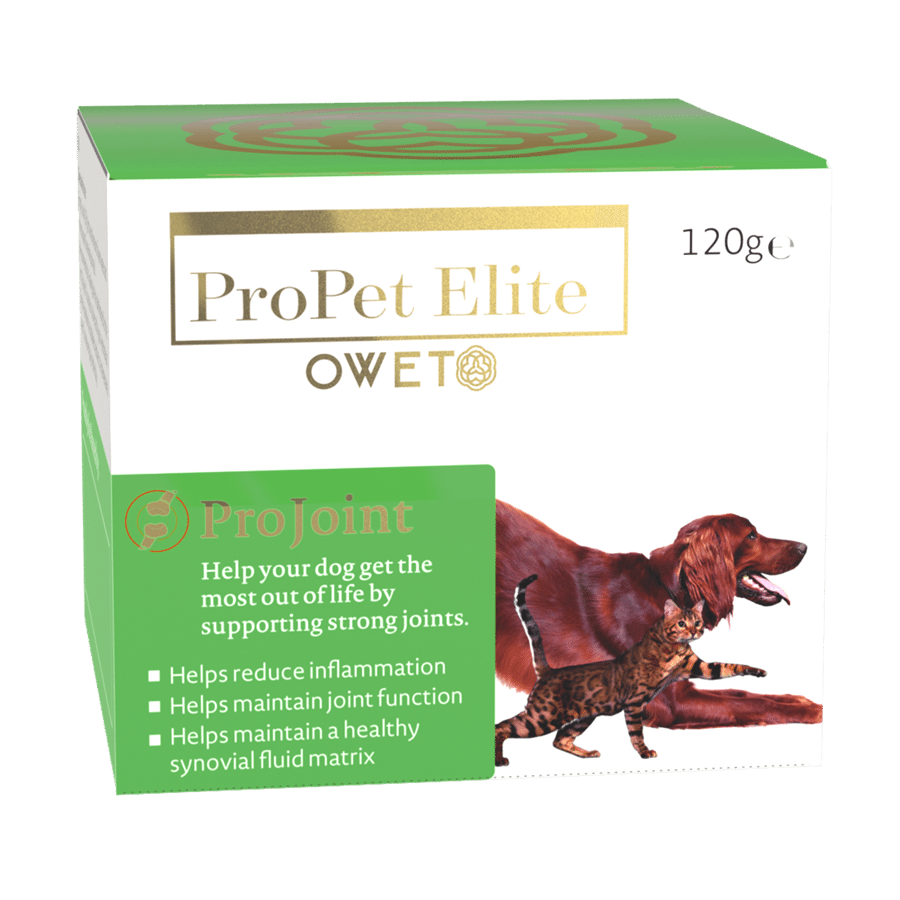Canine & Feline Arthritis DJD
(degenerative joint disease)
About 65% of dogs between the ages of 7 and 11 years have some degree of arthritis, with a greater proportion occurring in heavier and larger dogs. But while arthritis is more common in older dogs, it can appear in dogs of almost any age. Very commonly, an injury to a joint will lead to early onset of arthritis in that joint.
Canine hip dysplasia often leads to arthritis in the rear and can cause so much pain that the dog has difficulty walking. Even some infections and diseases can lead to arthritis.
OA is the most common form of arthritis and is present in 20% of dogs over one year of age (Hegemann et al., 2002). OA is also referred to as degenerative joint disease (DJD).
Prevalence of arthritis in cats
In one study published in 2002, 90% of cats over 12 years of age had evidence of degenerative joint disease (DJD). This included cats with so-called ‘spondylosis’ of the spine (a form of degenerative joint disease).
However, even when these cases were excluded, around 66% of the cats still had radiographic signs of arthritis affecting the limb joints. More recent studies have shown radiographic evidence of arthritis in the limb joints affecting between 60% and more than 90% of cats.
All these studies show that arthritis is actually very common in cats, that it is much more common (and more severe) in older cats, and that the shoulders, hips, elbows, knees (stifles) and ankles (tarsi) are the most commonly affected joints.
Osteo-Arthritis Development
These changes in the metabolic balance in the joint lead to the following changes in the pathology of the arthritic joint.
• Decreased Synovial fluid quality (viscosity), Cartilage failure, Vascular engorgement (an Immune response)
• Increased inflammation (synovitis) / Immune response. Cell necrosis, bone remodelling, bone necrosis
• Weight – Overweight dogs and cats are more prone to OA
• Stress Activity – Levels of high stress or abnormal activity for long periods of time, such as excess athletic activities can initiate the OA process.
• Joint injuries and trauma – injuries to the joint incite the OA process and encourage the ‘arthritis cycle’.
ProJoint is an effective nutritional supplement that supports the growth and maintenance of cartilage to ensure healthy and normal joint function. The healthy growth and function of cartilage within the joints benefits from specific nutrients at high levels.
This clinically proven formula that has exceptional levels of antioxidants, Omega 3 essential fatty acids, plus one of the most powerful antioxidants available, SOD, which is classified as a “Primary”. These natural ingredients have been well researched for their ability to assist in reducing inflammation, maintaining (GAG’s), and assisting in the reduction of pain and discomfort caused as a result of a breakdown in the synovial membrane.
ProJoint can help:
• Reduce joint pain
• Reduce inflammation
• Improve mobility
• Maintain healthy joints
Antioxidants
Free radicals are formed daily which are damaging to the whole body. Antioxidants act as scavengers to prevent cell and tissue damage, in particular SOD.
Down regulates oxidative stress, support a balanced immune system.
Omega 3
Omega 3 is required for synthesis of inter cellular connecting substances. The long-chain omega-3 fatty acids (EPA) and (DHA) are important in generating bioactive lipid mediators important in helping reduce inflammation.
Proven to support healthy joints.
Probiotics
Probiotics – Supports healthy levels of beneficial bacteria, which helps to maintain
propper pH levels. Improves feed efficiency and absorption of nutrieints, as well as helping maintain the immune system.
Mushrooms
Fungi have developed an arsenal of medicinal compounds with antibacterial and antiviral properties to protect themselves and in turn help protect anyone who consumes them. They are also classed as an adaptogenic. Ganomycin, a powerful modern antibiotic, comes from Reishi mushrooms.
Ingredients
Organic Whole mushroom powder – 5 Species
Synozym – Proprietary Plant based enzymes
Omega 3 rTG, EPA+ DHA
Golden Flaxseed- ALA
Saccharomyces Cerevisiae CNCM I-1077 (cfu*/g) 20 Billion
(European Authorization: E1711/4b1711/4a1711E)
Melofeed- Proprietary Melon extract rich in SOD
Serving Suggestions
Mix the powder with a small amount of warm water and mix into a paste. Apply to feed.
Additional information
| Size | 60g, 120g |
|---|
Switzerland
Herr Dr. Christoph Jäggin — click here
Dr. Frank Schellenberger — click here
Netherlands
Tops Vastgoed B.V.Edwina Tops-Alexander
Germany
Tierklinik Lüsche — click here
Herr Dr. Immo Müller
Klinik für PferdeDr. Jürgen Fischer
Tierärztliche Praxis für PferdeDr. Martin Hinrichsen
Verwaltungs- und HandelsgesellschaftDr. W. Jahn und Dr. V. Sill
Herr Dr. Marc FeldmannTierarztpraxis
Tierarztpraxis für PferdeHerr Dr. Bernhard Ekrod
Tierärztliche Praxis LichtenmoorDr. Veronika Sinz
Pferdeklinik Ankum GmbH
Frau Dr. Anja von DiekenTierarztpraxis
Herrn Dr.Matthias Meyer-Wilmes
Equivet VerlCarsten Dicks
Tierärztliche Hausapotheke
Pferdeklinik Duisburg GmbH Dr. Kathrin Rasch & Dr. Michael Novak
Frau Dr. Paticia ZweverinkPraktische Tierärztin
Dr. Joachim PietrowskiTierärztliche Praxis
Tierarztpraxis Kolberg Herrn Christian Kolberg
KALDENHOFF & VAN ‘T RIET GbR Apotheke
Herr Dr. Heribert Schürholz
Pferdeklinik Burg Müggenhausen — click here
Frau Dr. Agne Subaciute
Tierarztpraxis am Ravelsberg Dr. med. vet. Thomas Westenberger
Frau Dr. Ulrike Munnes-JugertTierarztpraxis
PraxisgemeinschaftDres. Michael Frevel & Gregor Heinekamp
Praxis für Pferde Michael Saxerprakt. Tierarzt
Firma TBW ApothekengesellschaftDr. Kai Kreling
Tierarztpraxis Gerhold GbR
TierarzneimittelDr. Norbert Beer
Frau Dr. Ulrike Häusler-Naumburger
Herr Dr. Wolfgang Krauss
Herr Dr. Norbert Wolff
Frau Dr. Marie Lindinger
Arzneimittelabgabe GbRDr. Adolphsen,Dr. Brems,E. Göschl,Dr. Wagner
Pferdeklinik am KirchbergDr. med. vet. Uwe Heidbrink
Tierklinik Dr. W. Doering

